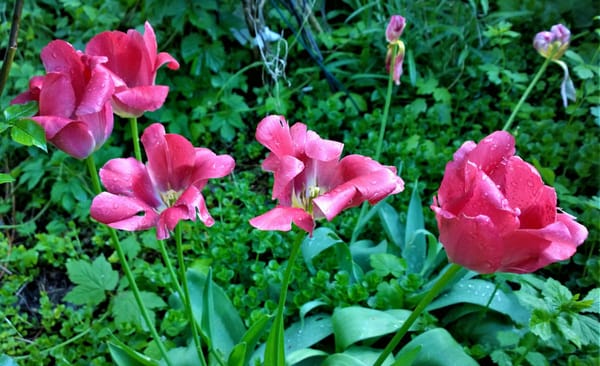Dispatch From The Garden: Hot, Hot, Hot (And Humid)
If you think it's hot and humid, so do your plants. Here's how to help them through the heat wave.

If you think it's hot and humid, so do your plants. Here's how to help them through the heat wave.

When did our region become the tropics? I don’t need to tell you we are all experiencing record-breaking heat and humidity this summer. And as much as we humans are suffering through these brutal conditions, our plants are suffering too. I am gobsmacked by the number of harmful insects and fungal problems that confront me daily as I make my rounds of clients’ gardens, attempting triage. Toasted plants here, webworms there, powdery mildew everywhere! It is frustrating, but rather than throw up your hands, prioritize a few chores that can help the garden make it through this season in the best shape you can manage.
The most important thing is to keep an eye on rainfall and make sure to water when necessary. Newly planted trees, shrubs and perennials should take precedence over mature plants. I try to water early or late in the day to prevent rapid evaporation, but if a plant is in severe distress, I get water to the root system ASAP, no matter what time of day it is. One caveat: Certain plants experience temporary wilting in the heat of the day to save moisture but will then rehydrate as the temperature cools later in the day. Big leaf hydrangeas are an example of this symptom. Dig down into the soil first if you aren’t sure — or you can end up overwatering a plant that responds to heat this way and kill it with “kindness.”
Watering deeply once a week for an hour is way more beneficial than dampening the soil daily down an inch or two, which encourages roots to grow near the soil surface where they’re vulnerable to drying out. Soaker hoses and drip irrigation are the best way to water so all of it penetrates the soil and gets to the roots. Apply water slowly so it’s fully absorbed rather than running off.
That said, containers are likely to need watering every day. Logically, the smaller they are, the quicker they dry out. Again, I try to water pots in the morning so they have access to it when they need it most. But if I don’t have time, I water in the evening when I get home.

The second area of importance in my garden tending is to remove distractions. In many cases, a plant that has insect or fungal damage with more brown or yellow foliage than not can be cut back all the way or down to new basal leaves. It is also good “gardenkeeping”. Fungal spores and insect eggs persist on dropped leaves and live to infect another day. Remove all debris and dispose in the garbage rather the compost pile.
Weeds don’t seem to suffer this weather the way our desirable plants do. They hog the moisture and rob the garden of nutrients. Keep up with that tedious chore and pull weeds before they go to seed, creating a gazillion more. If an area is perennially weedy, clean it out first and then apply a few inches of mulch to suppress existing seeds from germinating. Mulch is not just a cosmetic element, it provides more pluses in addition to weed suppression. Mulching around plants keeps the soil cooler and moister and helps prevents the surface from becoming hard and crusty, so water can penetrate to the root zone more easily.
Lastly, July and into August, deadheading spent flowers will keep your garden going past these difficult days and into the fall. Blooms fade more quickly in high heat and humidity but your plants want to keep blooming. Help them by snipping off the old flower heads and encouraging the nascent buds and side shoots to emerge.
Of course, as I write this, it is finally raining, thank goodness! But with the unpredictability of our weather this season, that’s no guarantee we will have consistent help from Mother Nature to get through the rest of it unscathed. Be careful out there, be vigilant and we, plants and people, will all survive this challenging bout of heat and humidity.








